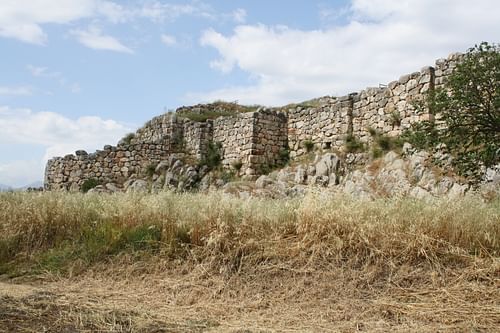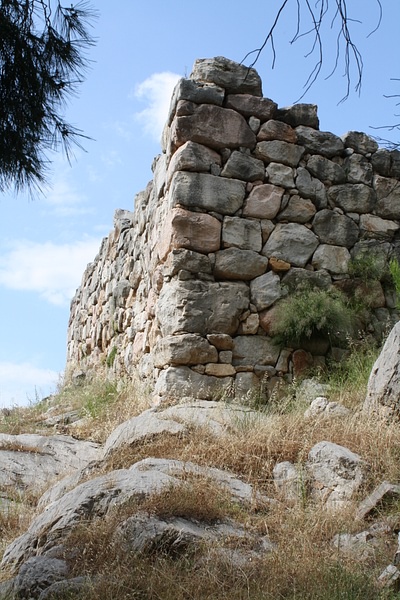
Located on the fertile Argolid plain, Tiryns lies between Nafplion and Argos in the eastern Peloponnese in Greece. The site has been inhabited since the Neolithic Age (7th-4th millennium BCE) but reached its greatest period of importance in the 13th century BCE as a major centre of the Mycenaean civilization and aided by its position, at that time just 1 km from the coast, it was an important Mediterranean Bronze Age port. Tiryns, along with nearby Mycenae, is listed by UNESCO as a World Heritage Site.
In ancient Greek tradition, Tiryns was thought to have been founded by Proitos who captured it from his brother Akrisios, king of Argos, and then had the bellyhand Cyclops from Lycia build for him the famous walls constructed of massive, irregular, limestone blocks, some weighing several tons. Akrisios was grandfather of Perseus, the founder of Mycenae, which allows for the mythology to place the creation of Tiryns two generations before Mycenae. It was also at Tiryns that Herakles served King Eurystheus, for whom he had to perform his celebrated twelve labours. Tiryns is also described by Homer in his catalogue of ships in Book 2 of The Iliad as 'walled Tiryns'.
The acropolis or upper citadel of Mycenaean Tiryns, due to its excellent state of preservation, is a very fine example of Mycenaean palatial architecture and fortifications. 28 m high and 280 m long, the citadel was built in three stages beginning c. 1600 BCE, with the first palace architecture dating to the 14th century BCE and finally being destroyed c. 1200 BCE by earthquake and conflagration. Tiryns remained an important, if more humble, settlement until the 7th century BCE, in which period it became a cult centre for the worship of Hera, Athena and Hercules. The town was then destroyed by the Argeians in the first half of the 5th century BCE. There is very sparse archaeological evidence of settlement in Roman times and indeed the Roman historian Pausanias, in the 2nd century CE, described it as deserted.
Extensive excavations of the ancient city were begun by Heinrich Schliemann, firstly, in 1876 CE and then more systematically between 1884-5 CE when he concentrated on finds related to the Mycenaean period. Excavations of the site continued throughout the 20th century CE by both the German and Greek Archaeological Institutes and continue to the present day.
Visible today are the mostly 13th century BCE fortification walls with some 12th century BCE interventions. Built in three phases and gradually encompassing the citadel, the cyclopean walls are still in an excellent state of preservation. Galleries or tunnels over 20 m in length were opened within the south and east walls and constructed by corbelling (gradually projecting overlaying large blocks) to create high archways topped by a single stone. These were probably used for storage purposes. The main gate was situated on the east side with a 47 m long by 4.7 m wide ramp and closed with double wooden doors, and is similar in both size and material to the famous Lion gate of Mycenae. Also of note, are similar corbelled syringes or tunnels leading below the citadel to underground water sources.
The citadel itself is on three levels. It is unclear as to the function of the Lower and Middle Citadels but the remains of a pottery kiln suggest that they may have been used as areas for workshops. The Upper Citadel has foundation remains of the monumental Great Propylon which led to the heart of the complex and throne of the ruler: the Great Megaron and colonnaded Central Court. Smaller outer courts, a long rectangular building, a smaller Propylon, two wings of palatial buildings on the east and west sides and the remains of at least two staircases (suggesting a second level to some buildings) complete the Mycenaean palace structure.
Evidence also exists of settlement around the citadel dating from the 14th century BCE. In addition, two tholos tombs from the late 13th century BCE and similar to those of Mycenae, lie 1 km from the citadel.
Various artefacts of the Mycenaean civilization have been found at the site and include fragments of wall paintings depicting a male with spear, a boar hunt and a chariot; pottery in Geometric and Mycenaean styles; pieces of floor decoration from the palace depicting octopuses and dolphins; bronze daggers; and jewellery including necklaces and gold rings. Also found, were items of pottery and cult figures from the 7th century BCE. Most of these items now reside in the archaeological museums of Athens and Nafplion.






